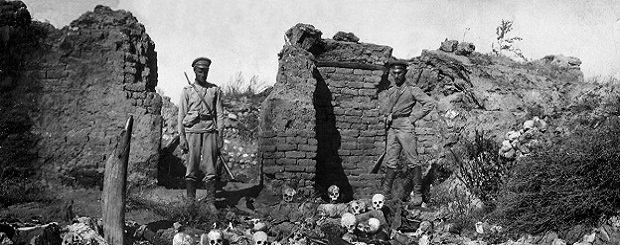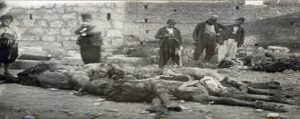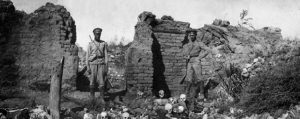
Armenian Genocide – April 10, 1992. The Maragha Massacre is a silent reminder of the genocidal behavior of Azerbaijan
NAZARETH BERBERIAN – AGENDA – April 10, 1992. The Maragha massacre is a silent reminder of the genocidal behavior of Azerbaijan
NAZARET PERPERIAN – AGENDA – THE PREVIOUS.

AGENDA:
April 10, 1992. The massacre at Maragha.
An undoubted reminder of the genocidal behavior of Azerbaijan
N. Berbèrian
On that day, April 10, 28 years ago, an anti-Armenian massacre with barbaric terror was added to the bloody “merit” of the genocidal behavior of Azerbaijan.
The Armenian village of Maragha, in the Martakert region of Artsakh, was subjected to a daily massacre planned by the state.
Carolina Cox, a prominent member of the House of Lords in the United Kingdom, became the undisputed witness to the Maragha massacre.
On the black pages of the Maragha massacre, which has an unforgettable place in the black pages of Artsakh’s war of liberation, Lady Carolina Cox presented the following testimony to the House of Lords in Great Britain.
“It was just brought to our attention. The village was completely destroyed. People buried the victims, or rather what was possible to bury – parts of a tortured, living, burned, cut or torn body. They buried some of them the day before, so we took them to film, even though we understood how difficult it was for the Armenians.
“What was filmed in Maragha at that time testifies to the horrible massacre which took place there: decapitated and mutilated corpses, corpses of children, bloody ground and parts of the body where they were torn apart. bloody hooks with which they had committed this crime, they probably should have taken them with us as evidence, but I couldn’t.
Azerbaijani riot police in Maraga, after the massacre of Armenians
“After killing the inhabitants, the Azeris looted and burned the village. After the soldiers, citizens appeared and continued to loot. We saw a few full bags that the corpses could not carry.”
Thus the former Armenian Maragha of Artsakh became the victim of the genocidal behavior of Azerbaijan.
Maragha was an Armenian village in the Martakert region, a thriving Armenian city on the Gandzak-Stepanakert highway and the gateway to Nagorno-Karabakh.
The inhabitants of Maragha were traditional Armenians, hospitable and indigenous, who cultivated mainly rice, owned orchards and gardens of fig and pomegranate trees.
Maragha gave Armenians well-known scientists, musicians and writers.
According to the 1989 census, Maragha had a population of 4,660 inhabitants.
The Turks have captured, killed and destroyed Maragha twice in the past century, in 1918 and 1920-21.
Second, the Maraghans have always distrusted their Turkish-Azerbaijani neighbors.
And in 1988, from the earliest days of the Karabakh movement, Maragha became one of the first fortresses in Artsakh to face danger.
Maragha found herself in the fire. The Turks made their first attempt to destroy the village in May 1991, but the village freedom fighters managed to courageously repel the attackers.

*
* *
In September 1991, the Armenians of Artsakh declared their independence, still part of the Soviet Union and based on Soviet constitutional laws.
The Armenians of Artsakh, who have embarked on the field of self-defense and the struggle for national liberation, have feverishly pledged to establish and strengthen the foundations and state structures of the Republic of Upper Karabakh.
But the general security of the Armenians of Artsakh was gravely compromised in December 1991, when the official dissolution of the Soviet Union collapsed, liberating and bringing to the whirlwinds of forestry law the nations and peoples held captive by the ‘Evil Empire for 70 years.
At this crucial geopolitical turning point, the newly independent Republic of Azerbaijan launched its genocidal plan to “denationalize” Artsakh in order to complete the depopulation and turquification of ancient Armenian lands and constructions.
Shushi has not yet been released and all Artsakh, as well as all ties with Mother Armenia, are still under the counterweight of Azerbaijani troops. The freedom-loving Armenians of Artsakh, who rebelled against the enemy who eats Armenians, suffered the deadly effects of bombing everywhere and every day.
The Maragha massacre took place in this fateful war of widespread bombardment and attacks with armored vehicles and heavy weapons.
At 5 a.m. on April 10, 1992, Maragha was suddenly targeted by an unprecedented amount of artillery fire. In the afternoon, the Azerbaijani military unit “Gurtulush” (1,000 soldiers) entered the village with 20 armored vehicles. Seeing that the Armenian Defense Forces (60 freedom fighters) would not be able to resist the unevenly excellent force of the enemy, they withdrew, warning villagers to retreat together or to the kings’ refuge .
The main population has left the village. The elderly and the disabled took refuge in the basements. The following day, the freedom fighters retook the village, but found the bodies of 57 civilians – some beheaded, others burned, shot or blindfolded … Here and there, literally torn parts of the human body were been thrown, hands and feet and …
Leith Cox, former vice-president of the British House of Lords, said at least 45 Armenians had been killed. According to the list of Armenian names, 57 civilians were killed and 45 taken prisoner. Among the captives were nine children, 18 women, three elderly people and a blind woman (confirmed by Helsinki Watch International Human Rights Watch and Caroline Cox).

*
* *
A week later, Maragha suffered a new attack, following which the population finally withdrew from its native cradle. A total of 90 people were killed and 37 others injured in the Azerbaijani barbaric genocide in Maragha, including 21 women and 6 children.
Thus, the Armenians were expelled and finally Maragha fell under the occupation of Azerbaijan. And to carry out the Maragha massacre, the commander of the “Gurtulush” battalion, Shahin Talib ogli Tagiyev, received the title of “National Hero of Azerbaijan”.
Making a political assessment of the Maragha massacre, the Ministry of Foreign Affairs of the Republic of Nagorno-Karabakh announced to the world:
“It was the lack of adequate political and legal assessment by the international community of the massacres and ethnic cleansing of the Armenian population in Azerbaijan that paved the way for the Azerbaijani army to commit war crimes in the village of Maragha .
“Impunity for these crimes has created fertile ground for radical hatred, xenophobia, intolerance and militaristic propaganda against Azerbaijan and the Armenians throughout Azerbaijan.
“In order to break this vicious circle and prevent the possibility of such crimes in the future, the massacre at Maragha must be condemned by the international community, and its organizers and perpetrators must be punished.”

NAZARETH BERBERIAN – AGENDA
ENGLISH TRANSLATION “lousavor avedis”
